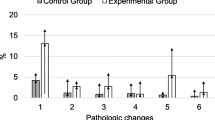Abstract
Purpose
Our purpose was to determine whether angiotensin converting enzyme (ACE) inhibitors affect gonadotropin-stimulated estradiol (E 2)production.
Design
This was a prospective, masked, randomized, placebo-controlled animal trial. Twenty female New Zealand White rabbits were hyperstimulated with gonadotropins. One-half of the rabbits received concomitant treatment with the ACE inhibitor, enalapril; one-half received concomitant treatment with a placebo.
Results
Baseline peripheral E 2 (13 ± 4 vs 11 ± 2 pg/ml) and angiotensin II (Ang II) (22 ± 5 vs 27 ± 7 pg/ml) levels were similar in both groups. Significant inhibition of peripheral Ang II levels was achieved in the enalapril group (32 ± 6 vs 93 ± 15 pg/ml; P =0.005).E 2 was significantly higher in the rabbits receiving enalapril versus placebo (369 ± 58 vs 183 ± 35 pg/ml, P <0.03), respectively. By day 10, peripheral E 2 had returned to normal levels in both groups (13 ± 1 vs 13 ± 1 pg/ml). However, E 2 levels in the ovarian effluent were 2.8 times higher in the enalapril rabbits.
Conclusion
Peripheral Ang II levels increase after gonadotropin stimulation and ACE inhibitors are able to blunt this increase significantly. ACE inhibition has a significant stimulatory effect on ovarian E 2 production. This implies that Ang II may normally inhibit ovarian E 2 production in stimulated cycles.
Similar content being viewed by others
References
Eskildsen PC: Localization of renin in rabbit uterus by help of microdissection. Acta Pathol Microbiol Scand 1972;80:241–244
Brown JJ, Davies DL, Lever AF: Variations in plasma renin during the menstrual cycle. Br Med J 1964;2:1114–1115
Paulson RJ, Do Y, Hsueh W, Lobo RA: Gradients of prorenin and active renin in ovarian venous and peripheral venous blood samples obtained simultaneously. Am J Obstet Gynecol 1988;159:1575–1578
Lightman A, Jones C, McLusky NJ, Palumbo A, Naftolin F: Immunocytochemical localization of angiotensin II immunoreactivity and demonstration of angiotensin II binding in the rat ovary. Am J Obstet Gynecol 1988;159:526–530
Morris RS, Paulson RJ: The ovarian derived prorenin to angiotensin cascade (ODPAC) in human reproduction. Fertil Steril 1994;62:1105–1114
Navot D, Bergh PA, Laufer N: Ovarian hyperstimulation syndrome in novel reproductive technologies: Prevention and treatment. Fertil Steril 1992;58:249–261
Pucell AG, Bumpus FM, Husain A: Rat ovarian angiotensin II receptors: Characterization and coupling to estrogen secretion. J Biol Chem 1987;262:7076–7080
Stirling D, Magness RR, Stone R, Waterman MR, Simpson ER: Angiotensin II inhibits luteinizing hormone stimulated cholesterol side chain cleavage expression and stimulates basic fibroblast growth factor expression in bovine luteal cells in primary culture. J Biol Chem 1990;265:5–8
Kitzman PH, Hutz RJ: In vitro effects of angiotensin II on steroid production by hamster ovarian follicles and on ultrastructure of the theca interna. Cell Tissue Res 1992;268:191–196
Yoshimura Y, Karube M, Oda T, Koyama N, Shiokawa S, Akiba M,et al.: Locally produced angiotensin II induces ovulation by stimulating prostaglandin production inin vitro perfused rabbit ovaries. Endocrinology 1993;133:1609–1616
Aguilera G, Millan MA, Harwood JP: Angiotensin II receptors in the gonads. Am J Hypertens 1989;2:395–402
Knox GE: Antihistamine blockade of the ovarian hyperstimulation syndrome. Am J Obstet Gynecol 1974;118:992–995
Pride SM, Yuen BH, Moon YS,et al.: Relationship of gonadotropin releasing hormone, danazol, and prostaglandin blockade to ovarian enlargement and ascites formation of the ovarian hyperstimulation syndrome in the rabbit. Am J Obstet Gynecol 1986;154:1155–1160
Kramer RE, Gallant S, Brownie AC: Actions of angiotensin II on aldosterone biosynthesis in the rat adrenal cortex. J Biol Chem 1980;255:3442–3447
Kimura T: ACTH stimulation on cholesterol side chain cleavage activity of adrenocortical mitochondria. Mol Cell Biochem 1981;36:105–122
Pucell AG, Bumpus FM, Husain A: Regulation of angiotensin II receptors in cultured rat ovarian granulosa cells by follicle stimulating hormone and angiotensin II. J Biol Chem 1988;263:11954–11961
Peperell JR, Nemeth G, Palumbo A, Naftolin F: The intraovarian renin angiotensin system.In The Ovary, EY Adashi, PCK Leung (eds.) New York: Raven Press, 1993;363–381
Rainey WE, Bird IM, Byrd W, Carr BR: Effect of angiotensin II on human luteinized granulosa cells. Fertil Steril 1993;59:143–147
Author information
Authors and Affiliations
Rights and permissions
About this article
Cite this article
Morris, R.S., Wong, I.L. & Paulson, R.J. Angiotensin converting enzyme inhibition of the gonadotropin-stimulated rabbit: Effect on estradiol production. J Assist Reprod Genet 12, 326–329 (1995). https://doi.org/10.1007/BF02213713
Received:
Accepted:
Issue Date:
DOI: https://doi.org/10.1007/BF02213713




